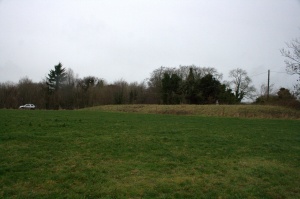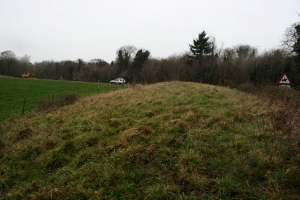4000BC – 3200BC EARLY NEOLITHIC
3200BC – 2300BC LATE NEOLITHIC
I wanted my first visit to be a Neolithic one, having confessed to it being my era of choice, and so it was that this afternoon I set off in rain and poor light to see my local earthen long barrow. Long barrows, along with causewayed enclosures and flint mines, are the recognised monument types of the early Neolithic, each of which have been found to contain human remains, and together they provide a fascinating glimpse into the practices of Neolithic people and numerous possibilities for speculation as to the structures’ functions and place within the wider Neolithic landscape. Bevis’s Thumb lies between Fernbeds Down and Telegraph Hill alongside the lane from Compton to the Mardens in the Chichester District of the South Downs and inhabits a peaceful location nestled in the corner of a field, skirted by a bramble hedge, beside a farm track.
The archaeology bit
I’d been there once before but still managed to miss it at the first attempt today. Once found though it’s hard to miss as it is one of the longest barrows in the south-east at 60 m with a width of 16 m at the western end although only 9 m at the eastern end which is truncated by the farm track, and 1.6-1.8 m high.
Earthen long barrows are the earliest monuments in Britain, many dating back to the first quarter of the fourth millenium BC. As is usually the case with the Neolithic (and the prehistoric period in general) there is little consensus on the role of these monuments and various theories exist. Certainly some contain human interments and this led to their original interpretation as burial monuments potentially for elite members of society or perhaps victims of warfare. It has been suggested that they may have been markers in the landscape (Renfrew, 1973; Chapman, 1981). There is much variety in the size and structure of long barrows and this makes generalisation difficult and provides archaeologists with an ongoing challenge in their attempts to decipher their function and meaning in the greater scheme of things.
There is a single radiocarbon date attributed to Bevis’s Thumb of 2500-2700 BC obtained from charcoal recovered from the bottom of the ditch during excavations in 1980 when a number of flint tools and animal bones were recovered. There are oval barrows to the south-east of Bevis’s Thumb which are possibly associated with it and a similar carbon date from the one at nearby North Marden could be combined to perhaps suggest that the barrows here are pre-dated by the local causewayed enclosures, which would be the opposite case to other areas in England where they are found. Long barrows and oval barrows are sometimes confused but they are two distinct categories within the suite of monuments for the Neolithic period as a whole. Around 500 long barrows are known throughout England and further examples are found in Wales, Scotland and Ireland. They are rectangular or trapezoid in shape and usually situated on raised areas in the landscape. Oval barrows, on the other hand, which are generally dated later than long barrows, are elliptical in shape and are found in more low-lying locations. They are far less common with only around 50 known examples which are found between Dorset and Norfolk with concentrations in East and West Sussex. The Neolithic period has long been seen as a time of peaceful farming communities living alongside each other in the landscape however more recent research has revealed a more complex picture of mobile herders at times involved in warfare whose lives centred around grand ritual practices at these places where their ancestors were often buried.
One thing I have definitely concluded is that long barrows are not the easiest thing to photograph. I wandered around the mound in the by now pouring rain, whacked up the ISO, and tried to find an angle to show the mound at its best. I largely failed but the picture below at least shows its scale due to the presence of my car. Below that is the view from the top which I just think is (slightly) more interesting and shows its proximity to the road by virtue of the sign to the right.
Folklore

 The Bevis in Bevis’s Thumb was apparently a legendary local giant (aka Beavis or Baverse) who purportedly ate an ox washed down with two hogshead of beer every week. Given the size of his thumb that doesn’t seem enough for one so huge – perhaps that’s where the tale falls down. The monument has also been known as Solomon’s Thumb which is thought to have been a Mediaeval Christianisation of its Pagan past.
The Bevis in Bevis’s Thumb was apparently a legendary local giant (aka Beavis or Baverse) who purportedly ate an ox washed down with two hogshead of beer every week. Given the size of his thumb that doesn’t seem enough for one so huge – perhaps that’s where the tale falls down. The monument has also been known as Solomon’s Thumb which is thought to have been a Mediaeval Christianisation of its Pagan past.
As a site to visit it won’t take long but I think it’s well worth taking a little walk alongside this ancient earthen mound and to appreciate its size and the effort that must have been involved in building it some 4500 years ago with nothing but primitive tools and manpower and to consider why the people of Neolithic would have gone to such lengths. Whose remains were interred there and why? How did this monument relate to contemporary ones in the local area and the wider region and indeed the rest of the country? What did the people of the time believe in? Short of travelling back in time, we will of course never have the definitive answers to these questions but it can be fun trying to work them out. And that, for me, is the joy of archaeology.
Refreshments
Pub-wise, the Coach and Horses in Compton serves Ballards and Langham ales, both excellent local micro-breweries. Alternatively, you could go in the direction of South Harting and visit the White Hart which serves Upham ales from Hampshire, the 3.6% Tipster being the most palatable in my view.
References
Chapman, R 1981 ‘The emergence of formal dispersal areas and the ‘problem’ of megalithic tombs‘. R. Chapman, I. Kines and K. Randborg (eds) The Archaeology of Death, 71-82 Cambridge: Cambridge University Press
Grinsell, L V 1936 The Ancient Burial-mounds of England. Methuen pp. 14, 80
Renfrew, C 1973 ‘Monuments, mobility and social organisation in Neolithic Wessex’ in C. Renfrew (ed) The explanation of culture change: models in prehistory, 539-588 London: Duckworth
Smith, M & Brickley, M 2009 People of the Long Barrows, Stroud: The History Press
SMR County monument no 0183 – Re Bevis’s Thumb long barrow
http://www.eng-h.gov.uk/mpp/mcd, accessed 04.01.2014
http://sussexpast.co.uk/wp-content/uploads/2011/08/06-09FRCF-for-web.pdf, accessed 04.01.14
